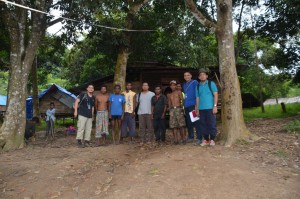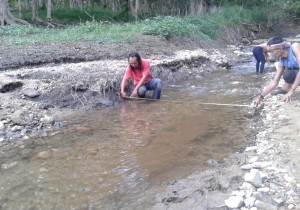The Potential of Micro-Hydropower Plant for Orang Asli Community in Royal Belum State Park
Shamsul Sarip, Khairul Kamarudin, Khamarrul Razak and Rozaimi Che Hasan
Corresponding author: shamsuls.kl@utm.my
Tel: 011-32085900
UTM Razak School of Engineering and Advanced Technology, UTM Kuala Lumpur, Jalan Sultan Yahya Petra, 54100 Kuala Lumpur , Malaysia
Introduction
4th Royal Belum Scientific Expedition was held in September 2015 involving researchers from all over Malaysia as well as researchers from Universiti Teknologi Malaysia especially from Razak School of Engineering and Advanced Technology. Study of sustainable renewable energy (SRE) at the urging of the necessities of life by indigenous communities who live in the Royal Belum State Park (RBSP). The need for electric power has never achieved consistently. In such case for helping those people, groups of researchers have been camped for a week to review and retrieve data for the effectiveness of sustainable energy in remote areas.
RBSP has several indigenous villages consist of Jahai community. Locality is defined as Kampung Sungai Tiang, Mount Chase, Kampung Sungai Leucogranite, Kampug Tourism Village, Kampung Sungai Sangho and Kampung Sungai Mendulum. Six small villages that existed since 1952 and is located to the north of Lake Temangor the largest man-made lake covering an area of 15200 hectares. The lake is formed when a dam of Temangor completion in 1975 and thus submerge Kampung Belum Lama and other small villages. Royal Belum forest part of Belum-Temangor Forest Complex is the world’s oldest about 130 years old. Belum-Temengor forest include RBSP (117,500 hectares), Hutan Simpan Grik (34,995 hectares) and Temangor Forest (147.505 hectares) [1-6].
Beginning with data collections in Kampung Kejar Hulu and Kampung Sungai Tiang, researchers have provided some question about the energy consumption in the house. This report focuses on the potential of micro-hydropower plant in RBSP due to its numerous rivers and canals providing off-grid power to the remote areas and also to the areas that are still outside the main grid network. The report reflects on the need to explore green energy thus proving how the establishment of widespread micro-hydropower plant can help overcome the current power crisis and play a role in the economic progress of the state. The survey to the potential sites and the means to identify new sites are outlined by performing hydrology studies, topographic studies, head calculations, turbine selection, and so forth.
UTM Researchers with community of Kampung Kejar Hulu
Cross- flow (Banki) Turbine
Mainly consists of 2 parts; nozzle and turbine runner. Water jet passes twice through the rotor blades. Applied over a wide head range (less than 2 m – more than 100 m). Relatively flat efficiency curve. Gained wide acceptance- due to simple construction, low cost of initial investment, easier maintenance and modest efficiency. Cross-flow turbines are used widely in such hydro-power plants due to their simple design, easier maintenance, low initial investment and modest efficiency.
Micro-hydro Power plants (5 kW -100 kW )
Solution to the power needs of small communities. Small hydraulic sites present a variety of economic advantages. Provide power for industrial, agricultural and domestic uses. Cost effective source for the rural communities not fed by the national grid.
Objective of Expedition
- Study the electrical energy consumption in Kampung Kejar hulu dan Kampung Sungai Tiang.
- Potential renewable energy in remote area.
- Identify areas for pilot micro-hydro turbine.
Method
Quantitative and Qualitative
Data were collected in and around Kampung Kejar Hulu and Kejar Base Camp. A total of 19 respondents participated in the survey consisted of 11 people from Kampung Kejar Hulu and 8 people of Kampung Sungai Tiang. Each respondent was composed of men who came from the tribe Jahai.
Kampung Kejar Hulu lead by Tok Batin Rudi
Measurement
Using measurement equipments such as meter gauge, some ropes, a buoy and a stop watch to calculate the stream flow rate. GPS is also used to determine the coordinates and elevation.
- Stream Flow rate calculation
- Pressure Head identified using GPS
Mess river during the dry season in September
Analysis
An analysis using SPSS software and map topology to determine the hydro system layout.
- SPSS
- Hydro system layout
Discussion
Suitable areas have been identified by using Quantitative and Qualitative method and identify suitable locations for the micro-hydro turbine system.
Mess waterfall
Conclusion
The results obtained from the 4th Royal Belum Scientific Expedition 2015 has found the suitable location for the construction of a micro-hydro power generation for the needs of Orang Asli. This system will provide a continuous source of electricity for 24 hours throughout the year with the advantage of low costs of construction and operating.
Future Work
Hopefully the good work will successfully carried out for supplying electricity for free of charge to the Orang Asli community and hopefully manage to get some fund from international and local agencies. Cost estimates were identified to build this system and hopefully local companies can provide some funds so that this project can be implemented as soon as possible.
References
- Emkay. Belum-Temengor Rainforest. http://www.bandingisland.com/index.php 2014 [cited 2014 Sept, 25].
- Suksuwan, S. and S. Kumaran, A Proposal for a Management Plan for the Royal Belum, Perak Darul Ridzuanwith some Recommendations. WWF MALAYSIA, 2003.
- Houben, I. Royal Belum State Park. http://www.wonderfulmalaysia.com/royal-belum-state-park-malaysia.htm 2007 [cited 2014 Sept, 25 ].
- JAKOA. Laman Web Rasmi Jabatan Kemajuan Orang Asli. http://www.jakoa.gov.my 2014 [cited 2014 Sept, 26].
- Shamsul Sarip (2014). Renewable energy harness to uplift the prosperity of Royal Belum Forest. National Conference on Royal Belum (NCRB) 2014.
- Khamarrul Azahari Razak*, RozaimiChe Hasan, Khairul Hisyam Kamarudin, Habibah @ Norehan Haron, Shamsul Sarip, Rudzidatul Akmam Dziyauddin, Sharihan Fathi (2015). Transroyal: Multi-Inter-Trans-Disciplinary Geo-Biosphere Research Initiatives in The Royal Belum and Temengor Forest Complex (RBTFC) Gerik Perak. International Conference on Sustainability Initiatives (ICSI) 2015 in conjunction with 8th ASEAN Environmental Engineering Conference (AEEC), Kuala Lumpur, Malaysia, 24-25 August 2015.
- Ramos, H., Guide Lines for Design of Small Hydropower Plants. 2000, Belfast, North Ireland: Western Regional Energy Agency & Network and Department of Economic Development.
- Bilal Abdullah Nasir (2014). Design Consideration of Micro-Hydro Electric Power Plant. Energy Procedia 50 ( 2014 ) 19 – 29






